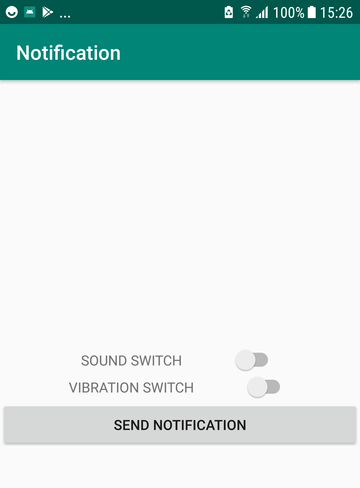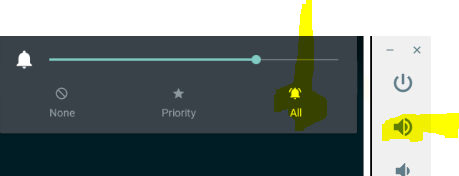Пользовательский звук уведомлений не работает в Oreo
Uri sound = Uri.parse(ContentResolver.SCHEME_ANDROID_RESOURCE + "://" + context.getPackageName() + "/" + R.raw.notification_mp3);
mBuilder.setSound(sound);
Я скопировал файл mp3 (messages_mp3.mp3) в папку raw в папке res. Когда срабатывает уведомление, оно воспроизводит заданный звук mp3 до Android Nougat, но звук по умолчанию в Android Oreo. Я ссылался на многие сайты, но на Android Oreo ничего не получалось. Я не нашел никаких изменений в Android Docs относительно звука уведомлений в Android O & выше. Какие изменения нужно сделать, чтобы этот код работал и в Android O?
9 ответов
Чтобы установить звук для уведомлений в Oreo, необходимо включить звук NotificationChannel и не на Notification Builder сам. Вы можете сделать это следующим образом
Uri sound = Uri.parse(ContentResolver.SCHEME_ANDROID_RESOURCE + "://" + context.getPackageName() + "/" + R.raw.notification_mp3);
if (Build.VERSION.SDK_INT >= Build.VERSION_CODES.O) {
NotificationChannel mChannel = new NotificationChannel("YOUR_CHANNEL_ID",
"YOUR CHANNEL NAME",
NotificationManager.IMPORTANCE_DEFAULT)
AudioAttributes attributes = new AudioAttributes.Builder()
.setUsage(AudioAttributes.USAGE_NOTIFICATION)
.build();
NotificationChannel mChannel = new NotificationChannel(CHANNEL_ID,
context.getString(R.string.app_name),
NotificationManager.IMPORTANCE_HIGH);
// Configure the notification channel.
mChannel.setDescription(msg);
mChannel.enableLights(true);
mChannel.enableVibration(true);
mChannel.setSound(sound, attributes); // This is IMPORTANT
if (mNotificationManager != null)
mNotificationManager.createNotificationChannel(mChannel);
}
Это установит пользовательский звук для ваших уведомлений. Но если приложение обновляется и канал уведомления используется ранее, оно не будет обновлено. то есть вам нужно создать другой канал и установить на него звук, чтобы он работал. Но это покажет несколько каналов в разделе уведомлений информации о приложении вашего приложения. Если вы устанавливаете звук на совершенно новый канал, это нормально, но если вы хотите, чтобы канал использовался ранее, вам нужно удалить существующий канал и воссоздать канал. Для этого вы можете сделать что-то подобное перед созданием канала
if (mNotificationManager != null) {
List<NotificationChannel> channelList = mNotificationManager.getNotificationChannels();
for (int i = 0; channelList != null && i < channelList.size(); i++) {
mNotificationManager.deleteNotificationChannel(channelList.get(i).getId());
}
}
Это может помочь новичкам.
Вот код рабочего образца уведомления для всех версий Android со всеми возможными настройками.
1 -> sound and vibration
2 -> sound but no vibration
3 -> no sound but vibration
4 -> no sound no vibration
ВЫХОД
Github Repo -> https://github.com/usman14/Notification
CODE
MainActivity
import androidx.appcompat.app.AppCompatActivity;
import androidx.core.app.NotificationCompat;
import android.annotation.TargetApi;
import android.app.Notification;
import android.app.NotificationChannel;
import android.app.NotificationManager;
import android.app.PendingIntent;
import android.content.Context;
import android.content.Intent;
import android.os.Build;
import android.os.Bundle;
import android.view.View;
import android.widget.Button;
import android.widget.CompoundButton;
import android.widget.Switch;
public class MainActivity extends AppCompatActivity {
public boolean shouldSound;
public boolean shouldVibrate;
NotificationManager notificationManager;
Button button;
Switch soundSwitch;
Switch vibrationSwitch;
@TargetApi(Build.VERSION_CODES.O)
public void registerNormalNotificationChannel(android.app.NotificationManager notificationManager) {
NotificationChannel channel_all = new NotificationChannel("CHANNEL_ID_ALL", "CHANNEL_NAME_ALL", NotificationManager.IMPORTANCE_HIGH);
channel_all.enableVibration(true);
notificationManager.createNotificationChannel(channel_all);
NotificationChannel channel_sound = new NotificationChannel("CHANNEL_ID_SOUND", "CHANNEL_NAME_ALL", NotificationManager.IMPORTANCE_HIGH);
channel_sound.enableVibration(false);
notificationManager.createNotificationChannel(channel_sound);
NotificationChannel channel_vibrate = new NotificationChannel("CHANNEL_ID_VIBRATE", "CHANNEL_NAME_ALL", NotificationManager.IMPORTANCE_HIGH);
channel_vibrate.setSound(null, null);
channel_vibrate.enableVibration(true);
notificationManager.createNotificationChannel(channel_vibrate);
NotificationChannel channel_none = new NotificationChannel("CHANNEL_ID_NONE", "CHANNEL_NAME_ALL", NotificationManager.IMPORTANCE_HIGH);
channel_none.setSound(null, null);
channel_none.enableVibration(false);
notificationManager.createNotificationChannel(channel_none);
}
@Override
protected void onCreate(Bundle savedInstanceState) {
super.onCreate(savedInstanceState);
setContentView(R.layout.activity_main);
button = findViewById(R.id.btn);
soundSwitch = findViewById(R.id.switch_sound);
vibrationSwitch = findViewById(R.id.switch_vibration);
notificationManager = (NotificationManager) getSystemService(NOTIFICATION_SERVICE);
if (isOreoOrAbove()) {
setupNotificationChannels();
}
button.setOnClickListener(new View.OnClickListener() {
@Override
public void onClick(View view) {
makeNotification();
}
});
soundSwitch.setOnCheckedChangeListener(new CompoundButton.OnCheckedChangeListener() {
@Override
public void onCheckedChanged(CompoundButton compoundButton, boolean b) {
if (b) {
shouldSound = true;
} else {
shouldSound = false;
}
}
});
vibrationSwitch.setOnCheckedChangeListener(new CompoundButton.OnCheckedChangeListener() {
@Override
public void onCheckedChanged(CompoundButton compoundButton, boolean b) {
if (b) {
shouldVibrate = true;
} else {
shouldVibrate = false;
}
}
});
}
private void setupNotificationChannels() {
registerNormalNotificationChannel(notificationManager);
}
public void makeNotification() {
NotificationCompat.Builder builder = new NotificationCompat.Builder(MainActivity.this, getChannelId())
.setContentTitle("Hi")
.setSmallIcon(R.mipmap.ic_launcher)
.setContentText("Welcome to Android");
Intent intent = new Intent(MainActivity.this, MainActivity.class);
PendingIntent pendingIntent = PendingIntent.getActivity(MainActivity.this, 0, intent, PendingIntent.FLAG_UPDATE_CURRENT);
builder.setContentIntent(pendingIntent);
if (shouldSound && !shouldVibrate) {
builder.setDefaults(Notification.DEFAULT_SOUND)
.setVibrate(new long[]{0L});
}
if (shouldVibrate && !shouldSound) {
builder.setDefaults(Notification.DEFAULT_VIBRATE)
.setSound(null);
}
if (shouldSound && shouldVibrate) {
builder.setDefaults(Notification.DEFAULT_ALL);
}
notificationManager = (NotificationManager) getSystemService(Context.NOTIFICATION_SERVICE);
notificationManager.notify(0, builder.build());
}
private String getChannelId() {
if (shouldSound && shouldVibrate) {
return "CHANNEL_ID_ALL";
} else if (shouldSound && !shouldVibrate) {
return "CHANNEL_ID_SOUND";
} else if (!shouldSound && shouldVibrate) {
return "CHANNEL_ID_VIBRATE";
} else {
return "CHANNEL_ID_NONE";
}
}
private boolean isOreoOrAbove() {
return android.os.Build.VERSION.SDK_INT >= android.os.Build.VERSION_CODES.O;
}
}
activity_main (xml)
<?xml version="1.0" encoding="utf-8"?>
<androidx.constraintlayout.widget.ConstraintLayout xmlns:android="http://schemas.android.com/apk/res/android"
xmlns:app="http://schemas.android.com/apk/res-auto"
xmlns:tools="http://schemas.android.com/tools"
android:layout_width="match_parent"
android:layout_height="match_parent"
tools:context=".MainActivity">
<LinearLayout
android:layout_width="match_parent"
android:layout_height="wrap_content"
android:gravity="center"
android:id="@+id/sound_layout"
android:orientation="horizontal"
app:layout_constraintLeft_toLeftOf="parent"
app:layout_constraintRight_toRightOf="parent"
app:layout_constraintTop_toTopOf="parent"
app:layout_constraintBottom_toBottomOf="parent">
<TextView
android:layout_width="wrap_content"
android:layout_height="wrap_content"
android:text="SOUND SWITCH"></TextView>
<Switch
android:layout_marginLeft="50dp"
android:layout_width="wrap_content"
android:layout_height="wrap_content"
android:layout_gravity="center_vertical"
android:id="@+id/switch_sound">
</Switch>
</LinearLayout>
<LinearLayout
android:id="@+id/vibration_layout"
android:layout_width="match_parent"
android:layout_height="wrap_content"
android:gravity="center"
android:orientation="horizontal"
app:layout_constraintLeft_toLeftOf="parent"
app:layout_constraintRight_toRightOf="parent"
app:layout_constraintTop_toBottomOf="@id/sound_layout">
<TextView
android:layout_width="wrap_content"
android:layout_height="wrap_content"
android:text="VIBRATION SWITCH"></TextView>
<Switch
android:layout_marginLeft="50dp"
android:layout_width="wrap_content"
android:layout_height="wrap_content"
android:layout_gravity="center_vertical"
android:id="@+id/switch_vibration">
</Switch>
</LinearLayout>
<Button
android:layout_width="match_parent"
android:layout_height="wrap_content"
android:text="Send Notification"
android:id="@+id/btn"
app:layout_constraintLeft_toLeftOf="parent"
app:layout_constraintRight_toRightOf="parent"
app:layout_constraintTop_toBottomOf="@id/vibration_layout"></Button>
</androidx.constraintlayout.widget.ConstraintLayout>
Примечание может помочь в тестировании эмулятора.
Для тех, кто не работает, обязательно отправьте идентификатор канала и название звука.
"notification" : {
"body" : "Pass body here",
"title" : "Title For Notification",
"icon" : " icon ",
"sound" : "my_alert.mp3" //Important
}
а также идентификатор канала в полезной нагрузке с вашего сервера
"channel_id": "myapp_notification_channel", // important
Обязательно передайте тот же идентификатор канала в конструктор
//pre oreo
builder = NotificationCompat.Builder(applicationContext, channelId)
//oreo
val notificationChannel =
NotificationChannel(channelId, "my_app", NotificationManager.IMPORTANCE_HIGH)
Убедитесь, что у вас тот же файл res/raw/my_alert.mp3
и используйте метод ниже, не используйте R.id.my_alert, как показано ниже
val alertSound = Uri.parse("${ContentResolver.SCHEME_ANDROID_RESOURCE}://${this.packageName}/raw/my_alert")
// and set like this
notificationChannel.setSound(alertSound, Notification.AUDIO_ATTRIBUTES_DEFAULT)
Создать канал (я использую этот метод в Application.clss создать канал)
public void initChannels(Context context) {
if (Build.VERSION.SDK_INT < 26) {
return;
}
NotificationManager notificationManager =
(NotificationManager) context.getSystemService(Context.NOTIFICATION_SERVICE);
NotificationChannel channel = new NotificationChannel("default"/*CHANNEL ID*/,
"CHANNEL_NAME",
NotificationManager.IMPORTANCE_DEFAULT);
channel.setDescription("Channel description");
assert notificationManager != null;
notificationManager.createNotificationChannel(channel);
}
И использовать этот канал default при создании экземпляра NotificationCompat
.... notificationBuilder = new NotificationCompat.Builder(this,"default") ....
mBuilder.setPriority(NotificationCompat.PRIORITY_HIGH)
Эта строка кода у меня работает. Но вы должны удалить старый канал и создать новый.
Привет, товарищи, во-первых, чтобы использовать звук уведомления устройства по умолчанию, добавьте следующее.
Uri uri = getDefaultUri(TYPE_NOTIFICATION); // To get the URI of default notification uri
AudioAttributes audioAttributes = new AudioAttributes.Builder().setUsage(AudioAttributes.USAGE_NOTIFICATION_RINGTONE)
.setContentType(AudioAttributes.CONTENT_TYPE_SONIFICATION).build();
И потом, извините, это может показаться глупым. Но вам также необходимо убедиться, что на устройстве установлено уведомление и звук по умолчанию, отличные от нуля. Я считаю, что это довольно легко упустить из виду.
Cheerio!
Android O поставляется с NotificationChannel, который использует вместо этого
int importance = NotificationManager.IMPORTANCE_HIGH;
NotificationChannel notificationChannel = new NotificationChannel(NOTIFICATION_CHANNEL_ID, "NOTIFICATION_CHANNEL_NAME", importance);
notificationChannel.enableLights(true);
notificationChannel.setLightColor(Color.RED);
notificationChannel.enableVibration(true);
notificationChannel.setVibrationPattern(new long[]{100, 200, 300, 400, 500, 400, 300, 200, 400});
assert mNotificationManager != null;
mBuilder.setChannelId(NOTIFICATION_CHANNEL_ID);
mNotificationManager.createNotificationChannel(notificationChannel);
Попробуй это:
/**
* show notification
*
* @param message
*/
private static void showNotification(RemoteMessage message, Context baseContext) {
Context context = baseContext.getApplicationContext();
NotificationManagerCompat managerCompat = NotificationManagerCompat.from(context.getApplicationContext());
NotificationCompat.Builder builder = new NotificationCompat.Builder(context, null)
.setSmallIcon(R.drawable.ic_logo_xxxdpi)
.setContentTitle(message.getData().get(TITLE))
.setContentText(message.getData().get(BODY))
.setPriority(NotificationCompat.PRIORITY_HIGH)
.setAutoCancel(true)
.setVibrate(new long[]{500, 500})
.setLights(Color.RED, 3000, 3000)
.setSound(Settings.System.DEFAULT_NOTIFICATION_URI)
.setContentIntent(getPendingIntent(context, message));
managerCompat.notify(getRandom(), builder.build());
}

